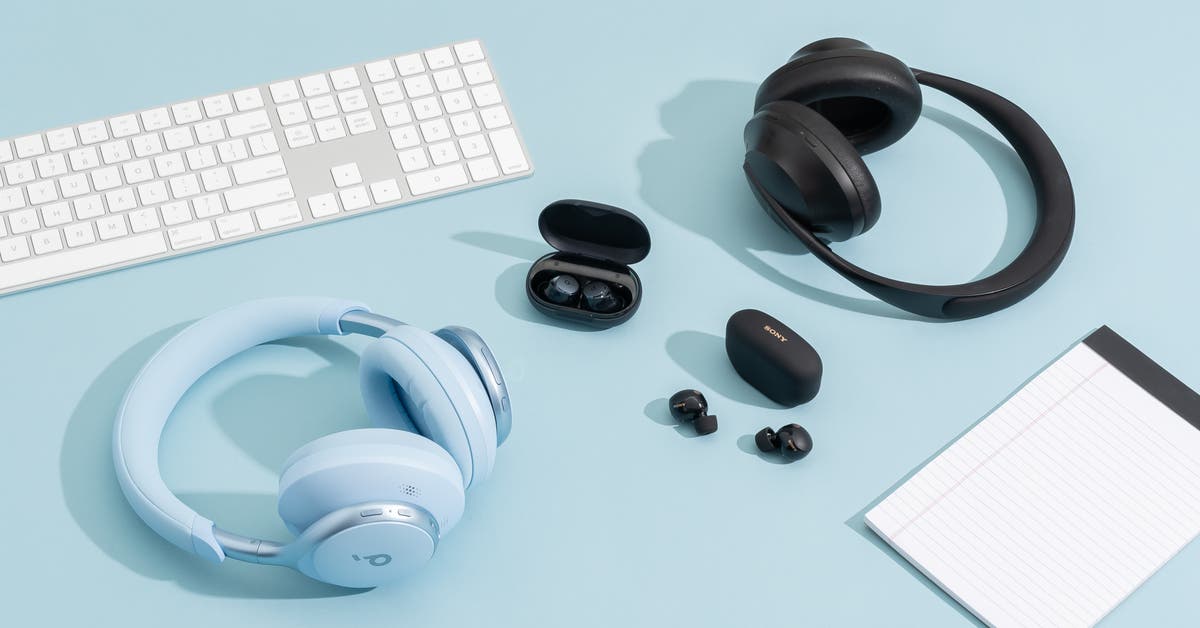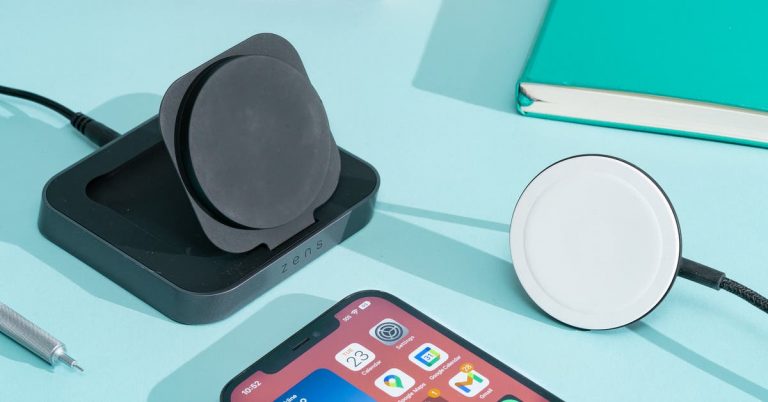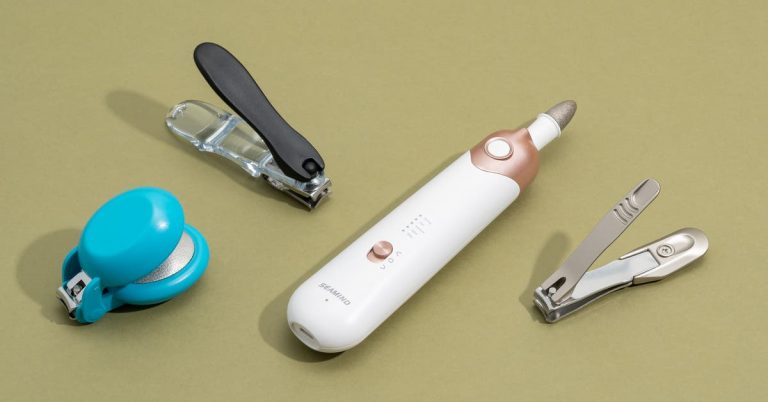The 4 Best Noise-Cancelling Headphones of 2025
We’ve tested more than 300 pairs of headphones for this guide. That’s a lot to cover, so we focus below on the newest and most high-profile competitors. However, if you’re curious about a specific model, we’ve archived many of our previous testing notes in a spreadsheet.
Over- or on-ear headphones
1More SonoFlow: This pair is our former budget headphones pick. The noise cancellation is effective, but it was bested by that of the Soundcore Space One headphones. The sound quality is pleasant and adjustable, and the design is lightweight and comfortable, though not as sturdy-feeling as the Space One. The 50-hour battery life with ANC on (70 hours with it off) is impressive for a model in any price range. However, the ANC does not work in wired mode, so if you’re on a plane that requires a wired connection to the in-flight entertainment system, you’ll have to either go without ANC or pick up a Bluetooth transmitter.
1More Sonoflow HQ51: This pair has strangely positioned controls, middling noise cancellation, and a muffled transparency mode. The pair we tested had an offensively strong plastic or chemical odor when we took it out of the box.
1More SonoFlow SE: A bare-bones edition of the SonoFlow, this set has similar battery life/quick-charge capabilities, app-adjustable tuning, and a lightweight design. But the SE lacks the water resistance, software-driven noise-cancelling microphone, and ability to listen wired. The noise cancellation doesn’t sound as effective as the original, and we noticed that facing the source of a noise resulted in less reduction than when we turned to the side. The hear-through mode sounds muffled, but the microphone does a good job of reducing background noise for phone calls. If you want to spend the least amount possible for decent ANC headphones, this pair is light and comfy, sounds good, and reduces some noise, but we think spending a bit more for our budget pick is worth it for the extra functionality.
Baseus Bowie 30 Max: The noise cancellation was average, but the sound was inconsistent—the balance changed when we turned the ANC on and off. Whichever way you listen, this pair can’t play very low notes: In our tests, the range from 20 to 35 Hz was just a toneless thump, and the bass level from 35 to 80 Hz was very low in volume.
Beats Studio Pro: For every positive, this pair has an equally disappointing downside. The noise cancellation and hear-through modes sound great, but neither is adjustable. It’s easy to use the larger physical buttons, but the power/ANC toggle button is inexplicably small. The foam earpads are soft but not replaceable. Android users get a dual-device connection feature; Apple users do not. There are three EQ settings, but they’re only accessible when listening via USB-C. But most importantly, the sound quality is dramatically impacted by use of the spatial audio: When it’s turned on, the lower bass is emphasized, and higher-pitched sounds have an artificial sharpness. With spatial audio off, the bass is notably diminished.
Bose QuietComfort Headphones: These are good headphones, but they aren’t remarkable enough to justify the $350 price. The ANC is not as effective as what the rest of the current Bose line can deliver. In fact, at the highest intensity, these headphones reduced less noise in the airplane band than our budget pick. Despite this, the amount of reduction is still effective and useful, and the ANC intensity is adjustable. The build is very comfortable, with a lightweight feel and squishy earpads that should accommodate many glasses arms. These headphones utilize physical buttons rather than the touch controls, and the buttons are easy to learn and find. The hear-through mode sounds natural, and music sounds good, albeit slightly bass-forward out of the box. The Bose app provides an EQ feature that can adjust the tuning, but it consists of only three faders, which is too simplistic. The microphones sound very clear in a quiet room, but background noises in the human vocal range, like a sink running nearby, will be pronounced. We love that Bose includes a cable with a three-button remote and mic—a rare old school nicety.
Cambridge Melomania P100: This pair provides above-average noise cancellation—an average of 19 dB of reduction. We like the powerful bass, the superb clarity for phone calls, and the option to use comedian Matt Berry’s voice for system alerts. Out of the box, the low notes were too intense for our taste, and the high frequencies had a slight whistle-like quality to them, but after we made some adjustments to the app’s EQ settings, the P100 sounded really great. What we didn’t like was that the P100’s build is on the heavier side, and its case is sizable—making it tougher to fit in a bag. With phone calls, the side tone sounds as though your voice is coming through a paper-towel tube, and we wish that there was a way to disable the auto-play feature. These are minor flaws, but they were enough to keep this pair from being a top pick.
Creative Zen Hybrid SXFI: This pair is solid but unexceptional. The noise cancellation is good but not superlative. The same can be said about the sound. And the earcups are very shallow, so people with larger or protruding ears will feel the pressure.
Dyson OnTrac: This snazzy-looking pair was disappointing to use. The noise cancellation was on a par with that of $100 sets, the three sound profiles were all flawed, and the toggle control was tricky to use. Unfortunately, these headphones are hefty as well, so the headband began to press uncomfortably after an hour or so of our wearing them.
EarFun Free Wave Pro: This affordable pair sounds good for the price, and given the inclusion of multiple EQ presets and a hearing-test-based tuning process, most people should be able to find a sonic balance they like. However, the ANC isn’t as powerful as that of the Soundcore Space One, the hear-through mode doesn’t sound as natural, and the headband transfers some noise when you bump it.
Raycon Everyday Headphones Pro: This pair is unoffensive, but also unremarkable. The ANC is middle-of-the-road, and the three EQ settings are all exaggerated, with a harsh twang to piano sounds and a compressed soundstage (though the Bass mode could be fun if you like a bumping hip-hop feel). The microphone sounds clear in a quiet room, but it picks up every little high-pitched background noise and gives your voice a sibilant quality.
Sennheiser Accentum Plus: This pair has smaller earcups that feel refreshingly streamlined, but they might be a touch too small for folks with larger ears. Out of the box the sound is quite nice, with an extra bass bump that is most noticeable with hip-hop and rap tunes. There’s also extra intensity in the highs that could be perceived as either added detail or sibilance, depending on your ears. If you want to EQ the sound, you’ll need to create an account in the app and take an unusual sound-preference test that asks how loud you like drums or strings. There’s no option to use faders to fine-tune the sound yourself. The active noise cancellation isn’t as effective as what our picks deliver, and the microphone quality makes you sound compressed, like you’re on an old-school landline.
Sennheiser Accentum Wireless: The headband on this pair is tight, so those with large or sensitive heads won’t enjoy the fit. The noise cancellation is only average, and the sound contains unrestrained low notes and high-frequency sibilance around 8 kHz—neither of which can be addressed through the app’s EQ tool.
Skullcandy Crusher ANC 2: This pair isn’t for most people. The noise cancellation was minimal. The sound was bass-heavy to begin with, and when we enabled the “crusher” setting, it added vibration and reverb to a ridiculous degree. You can adjust the sound via EQ or a hearing test, but you can’t make the adjustments in the app while your music is playing, so it’s hard to find the ideal sound preference.
Skullcandy Icon ANC: On-ear headphones are a rarity these days, so we were disappointed to discover that this pair was especially tight and the earcups didn’t swivel. Worse still, the noise cancellation was barely effective.
Sonos Ace: This pair is lightweight and comfortable, with a look that’s minimalist and elegant. However, the sound leans toward being bottom-heavy with less intensity in the highs—a response frequently described as “warm” or “dark.” The Sonos app does provide EQ capabilities, but there are only two clumsy faders that fail to resolve any issues. The ANC didn’t measure as well as we’d hoped—an average of 9.8 dB—and the surround sound effect is akin to reverb in a large auditorium. It muddies quiet dialog. The Ace can connect to the Sonos Arc soundbar, and you can swap TV sound between the two; but the setup process can be buggy. We wish that the Ace could perform the same trick with other Sonos devices, but for now you’ll need to connect to other devices via the traditional Bluetooth pairing process, since this pair lacks Wi-Fi capabilities.
Sony ULT Headphones: This set has a lot of the design niceties of the Sony WH-1000XM5: palm-to-earcup hear-through activation, Alexa compatibility, and excellent noise cancellation. The build isn’t quite as lux as the XM5’s, but the overall design is similar. However, bass notes sound boomy out of the box, and downright unhinged when you press the ULT button. Maybe because we’ve never been the sort to purchase seat-rattling subwoofers for our cars, we couldn’t get past the sound.
Soundmagic P58BT: The ANC is intense in a narrow band; people prone to eardrum suck are likely to feel the effect immediately. The sound is dull with coarse highs, and there is no app for you to adjust it.
Earbuds
AirPods 4 with Active Noise Cancellation: If you can’t stand the feeling of sealed earbuds and want some noise cancellation, this pair is the only option out there. For everyone else, we think you can get better performance from our picks. Read more of our thoughts.
Beats Powerbeats Pro 2: If you’re looking specifically for Apple-friendy workout earbuds, this pair is a pricey but solid choice. The earbuds hook over the ears and feel very secure during workouts, and this set has a built-in heart-rate monitor that works well. The battery life of eight to 10 hours is good, and we liked how these earbuds sounded. But from a noise-cancelling perspective, the ANC in this pair isn’t as effective as that of the similarly priced AirPods Pro 2 or the Sony WF-1000XM5—though the Beats’s sealed design passively blocks higher-frequency sounds better than the vented AirPods. If you’d like to read more about how this pair compares to other workout earbuds, check out our guide to the best workout earbuds and headphones.
Beats Studio Buds +: The upgraded version of the Studio Buds, this pair offers better battery life (nine hours), Android customization, and noise cancellation compared with the original—and a stylishly transparent shell. But the core earbud design remains the same. This is a solid pair of earbuds overall and shares a lot of iOS-friendly features with the Beats Fit Pro set—but we like the Fit Pro earbuds better because they’re more secure in the ears, they still offer better noise cancellation, and their button design is more ergonomic.
Bose QuietComfort Earbuds: This pair is large, so the majority of our panelists found them uncomfortable. Plus, the noise cancellation didn’t measure as well as that of our budget earbud pair.
Bose QuietComfort Ultra Earbuds: This pair replaces the QuietComfort Earbuds II and is excellent at reducing noise. These earbuds measured second only to the Sony WF-1000XM5 at reduction in the airplane band. But the way the reduction functions can cause a lot of eardrum suck, so if you’re susceptible, you may need to dip the ANC intensity for comfort. The fit is secure, and the sound is consistent with the quality and tuning Bose is known for. In other performance areas, Bose said that the Ultra pair remedied some issues that marred its predecessor, but that wasn’t our experience. Phone calls are still problematic. Though the microphones perform well in quiet settings, the sound falls apart with any level of background noise. On one test call, ordinary street sounds rendered our caller unable to understand us. Plus, the Ultra Earbuds still lack dual-device connectivity. The hear-through mode is designed to automatically duck the volume when you’re in a noisier area, but the effect is way too heavy-handed. We also weren’t impressed with the Immersive Audio mode, which made music sound like a speaker playing from a specific point in a metal hallway. Six hours of battery life per charge (four with Immersive Audio active) is low for earbuds that lack an always-listening assistant. For a pair that’s originally priced at $300, we expect better and more.
Cambridge Audio Melomania M100: Although this pair sounds quite good (with some EQ tinkering in the app) and offers comedian Matt Berry as an optional menu voice, the ANC is mild, the hear-through has a stuffy-headed quality, and the case is bigger than average. We enjoyed listening to them, but if ANC is a priority, these aren’t for you.
Denon PerL: This pair of earbuds has a distinctive look—they’re the size of quarters and look like ear gauges. The fit is comfortable, but the ANC is mild and focused on very low-pitched sounds. The hear-through mode is quiet, sounds muffled, and doesn’t work while playing music, which limits situational-awareness options. The app has a personalized EQ function that varied in success for us. We got one result that made male vocals sound buried and another in which high frequencies were piercing. And there is no way to adjust the sound yourself.
Denon PerL Pro: This pair has many of the same flaws as the lower-priced PerL, but at least it offers manual EQ adjustments, which we used to find a sound profile we enjoyed. Overall, though, the original $350 price is too steep to recommend this pair.
Edifier TWS1 Pro 2: If you’re on a tight budget, this is the only under-$50 pair of noise-cancelling earbuds we’ve tested that won’t immediately inspire buyers remorse. While this pair doesn’t have the level of performance of our picks, it nonetheless reduces noise in a useful way, and the sound quality is excellent for the price. We like the IP54 water/dust resistance, and the adjustable awareness mode, too. But the battery life of four hours with ANC on is too short, and the suite of touch controls is limited.
Jabra Elite 4: Though the earbud design is comfortable and the full suite of controls is intuitive, active users might feel as though these earbuds aren’t secure enough in their ears. The noise cancellation is minimally effective, and the sound is just okay—the highs have a sizzling aspect that the five-band EQ can’t fix. Five and a half hours of battery life is decent, but not great.
JLab Epic Edition: These earbuds come with a USB-C Bluetooth transmitter that can store neatly inside the charging case. This pair’s adjustable ANC is effective, and the microphone sounds super clear on calls, even in wind. The sound is fantastic, especially the “Knowles signature” EQ setting. The earbuds offer nine hours of battery life, IP55 water and dust resistance, and a two-year warranty. We would make this pair a pick if the earbuds were more friendly to small ears, but sadly they’re a touch chunky with no additional stabilization.
Master & Dynamic MW09: The sound on this pair didn’t impress, even after tinkering with the manual EQ, and the noise cancellation is middle-of-the-road. We do like the physical volume controls and the luxurious feel, but these might benefit from a wing-style securing method, as the design is on the hefty size. Overall these are good earbuds, but for the original $300 price, we want something great.
Nothing Ear (2): Although not on a par with our top picks, this pair’s average of 14.5 dB of ANC reduction is quite good. Nothing’s app is very well designed, with some beneficial personalization of ANC and EQ that make the listening experience quite pleasant. The fit is comfortable, the microphone quality is clear, and the futuristic design could be appealing to some. However, the squeeze-style controls are limited and very frustrating to use. Not only are they prone to misreading your squeeze, but the act of squeezing can dislodge the earbuds and is likely to be difficult for people with dexterity issues.
Phiaton BonoBuds Plus: The earbuds fit comfortably, and the ANC is decent—but not superlative. The EQ adjustment isn’t nimble enough to compensate for the bass range’s bloated, booming sound. Even after installing firmware updates, we found that using this pair was buggy. For example, auto-play would occur even after we disabled that feature in the app.
Raycon The Everyday Earbuds Pro: This pair is comfortable, and the ANC is helpful at reducing low-pitched hums. However, the bass is blobby and incredibly loud. Even acoustic guitars sound formless and boomy, and there is no way to EQ this pair.
Samsung Galaxy Buds 2 Pro: The fit is comfortable, the case is adorably small, and the sound is flawed yet still pleasant. But the noise cancellation is significantly less successful than we’d like, and the Buds 2 Pro pair doesn’t offer dual-device connectivity. The touch controls are easy to inadvertently activate when you’re adjusting the earbuds in your ears. And the voice-activated hear-through mode isn’t as seamless as that of the Sony WF-1000XM5.
Sennheiser Momentum TW4: This is a good but expensive set of earbuds. The ANC and isolation work well to reduce distractions around you, and the transparency mode sounds relatively natural. The touch controls are easy to use. Out of the box, the sound is somewhat bass heavy, but you can adjust the intensity using the manual EQ in the app. Although the earbud design is comfortable for medium and large ears, people with smaller ears may struggle with the fit. Also, high frequencies become sibilant if you boost them more than 2 dB or so in the EQ, and the case is on the chunkier side—like a twinkie cut in half. If the TW4 earbuds weren’t $300, we would give these minimal flaws a pass.
Soundcore P40i: Overall, this is a nice pair of earbuds with some notable flaws. First, the orientation of the stem on the earbud is such that larger ears may have trouble getting the earbuds deep enough to get a seal. The touch controls are customizable but limited. We liked the bass-forward sound once we adjusted it using the EQ feature in the app. However, the sound loses clarity and balance when played at lower volumes. The ANC is adjustable and performs well, but the “smart” adaptive feature was divisive. Some testers found it to be helpful, and others found it disorienting.
This article was edited by Adrienne Maxwell and Grant Clauser.






